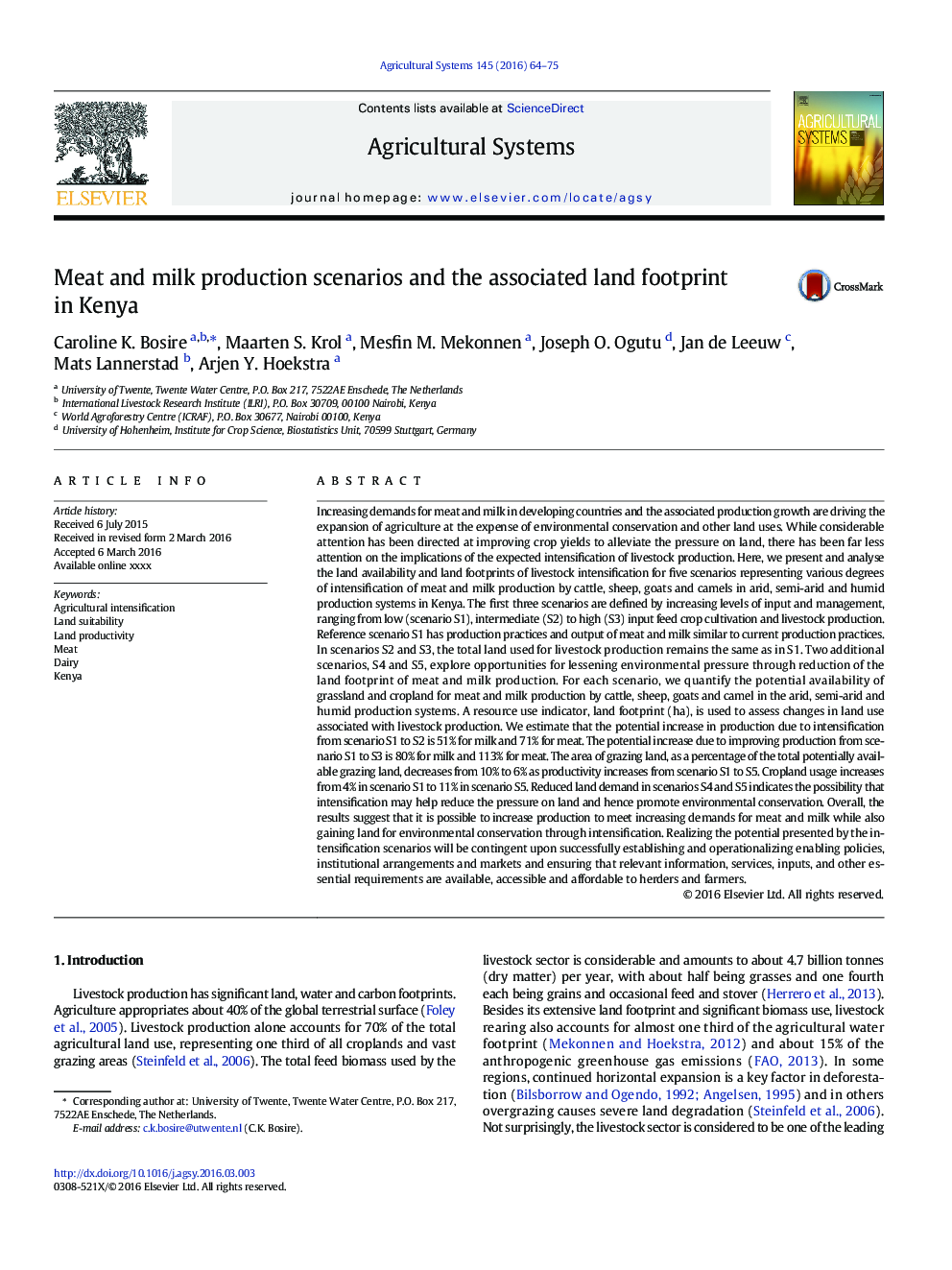| کد مقاله | کد نشریه | سال انتشار | مقاله انگلیسی | نسخه تمام متن |
|---|---|---|---|---|
| 6368399 | 1623225 | 2016 | 12 صفحه PDF | دانلود رایگان |
عنوان انگلیسی مقاله ISI
Meat and milk production scenarios and the associated land footprint in Kenya
ترجمه فارسی عنوان
سناریوهای تولید گوشت و شیر و ریزش زمین در کنیا
دانلود مقاله + سفارش ترجمه
دانلود مقاله ISI انگلیسی
رایگان برای ایرانیان
کلمات کلیدی
تشدید کشاورزی، مناسب بودن زمین، بهره وری زمین، گوشت لبنیات، کنیا،
موضوعات مرتبط
علوم زیستی و بیوفناوری
علوم کشاورزی و بیولوژیک
علوم کشاورزی و بیولوژیک (عمومی)
چکیده انگلیسی
Increasing demands for meat and milk in developing countries and the associated production growth are driving the expansion of agriculture at the expense of environmental conservation and other land uses. While considerable attention has been directed at improving crop yields to alleviate the pressure on land, there has been far less attention on the implications of the expected intensification of livestock production. Here, we present and analyse the land availability and land footprints of livestock intensification for five scenarios representing various degrees of intensification of meat and milk production by cattle, sheep, goats and camels in arid, semi-arid and humid production systems in Kenya. The first three scenarios are defined by increasing levels of input and management, ranging from low (scenario S1), intermediate (S2) to high (S3) input feed crop cultivation and livestock production. Reference scenario S1 has production practices and output of meat and milk similar to current production practices. In scenarios S2 and S3, the total land used for livestock production remains the same as in S1. Two additional scenarios, S4 and S5, explore opportunities for lessening environmental pressure through reduction of the land footprint of meat and milk production. For each scenario, we quantify the potential availability of grassland and cropland for meat and milk production by cattle, sheep, goats and camel in the arid, semi-arid and humid production systems. A resource use indicator, land footprint (ha), is used to assess changes in land use associated with livestock production. We estimate that the potential increase in production due to intensification from scenario S1 to S2 is 51% for milk and 71% for meat. The potential increase due to improving production from scenario S1 to S3 is 80% for milk and 113% for meat. The area of grazing land, as a percentage of the total potentially available grazing land, decreases from 10% to 6% as productivity increases from scenario S1 to S5. Cropland usage increases from 4% in scenario S1 to 11% in scenario S5. Reduced land demand in scenarios S4 and S5 indicates the possibility that intensification may help reduce the pressure on land and hence promote environmental conservation. Overall, the results suggest that it is possible to increase production to meet increasing demands for meat and milk while also gaining land for environmental conservation through intensification. Realizing the potential presented by the intensification scenarios will be contingent upon successfully establishing and operationalizing enabling policies, institutional arrangements and markets and ensuring that relevant information, services, inputs, and other essential requirements are available, accessible and affordable to herders and farmers.
ناشر
Database: Elsevier - ScienceDirect (ساینس دایرکت)
Journal: Agricultural Systems - Volume 145, June 2016, Pages 64-75
Journal: Agricultural Systems - Volume 145, June 2016, Pages 64-75
نویسندگان
Caroline K. Bosire, Maarten S. Krol, Mesfin M. Mekonnen, Joseph O. Ogutu, Jan de Leeuw, Mats Lannerstad, Arjen Y. Hoekstra,
